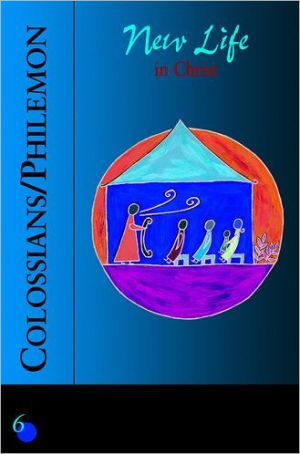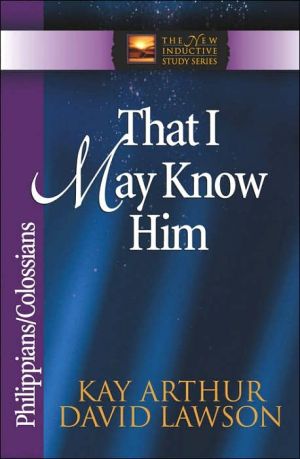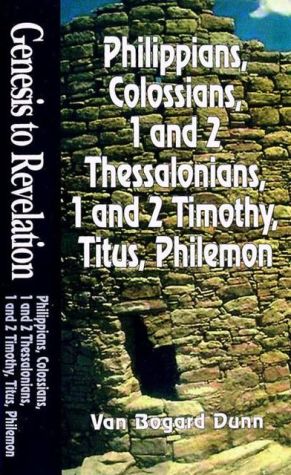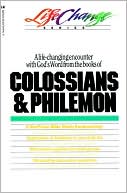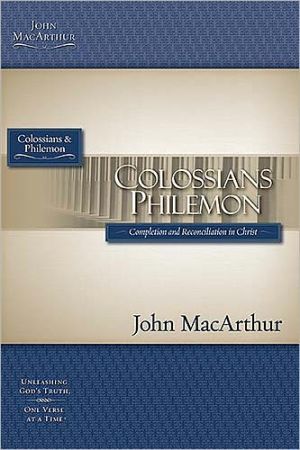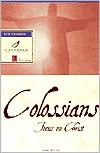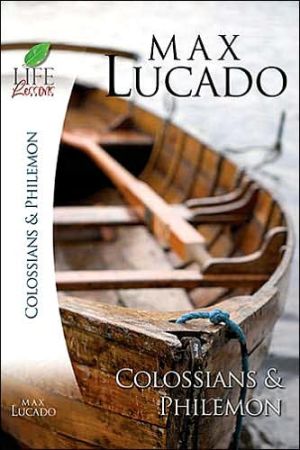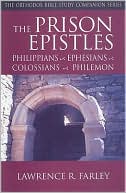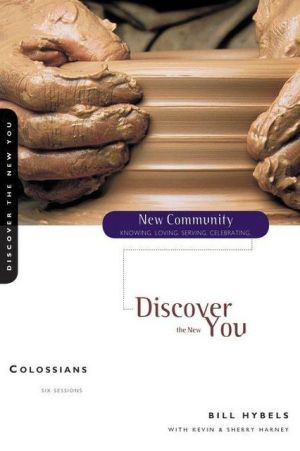Six Weeks with the Bible: Colossians and Philemon: New Life in Christ
In Colossians and Philemon, two short but important letters of Paul, the gospel message is applied to Christians' everyday problems. Colossians/Philemon: New Life in Christ in an excellent way to introduce people to the letters of Paul while demonstrating the relevancy of Paul's message for people today.\ A Guided Discovery of the Bible The Bible invites us to explore God’s word and reflect on how we might respond to it. To do this, we need guidance and the right tools for discovery. The Six...
Search in google:
How to Use This Guide\ \ You might compare the Bible to a national park. The park is so large that you could spend months, even years, getting to know it. But a brief visit, if carefully planned, can be enjoyable and worthwhile. In a few hours you can drive through the park and pull over at a handful of sites. At each stop you can get out of the car, take a short trail through the woods, listen to the wind blowing through the trees, get a feel for the place.\ In this booklet we will read two letters: an open letter from St. Paul (or one of his disciples) to the Christian communities at Colossae and Laodicea, and a personal letter from Paul to Philemon, a Christian coworker from Colossae. Because the letters are brief, we will be able to take a leisurely walk through them, thinking carefully about what we are reading and what it means for our lives today. While the letters are short, they give us much to reflect on, for they tell us a great deal about who Christ is and how Christ’s followers should treat one another.\ This guide provides everything you need to explore Colossians and Philemon in six discussions—or to do a six-part exploration on your own. The introduction on page 6 will prepare you to get the most out of your reading. The weekly sections provide explanations that highlight what the words of Scripture mean for us today. Equally important, each section supplies questions that will launch your group into fruitful discussion, helping you to both investigate the letter for yourself and to learn from one another. If you’re using the booklet by yourself, the questions will spur your personal reflection.\ Each discussion is meant to be a guided discovery.\ Guided. None of us is equipped to read the Bible without help. We read the Bible for ourselves but not by ourselves. Scripture was written to be understood and applied in the community of faith. So each week “A Guide to the Reading,” drawing on the work of both modern biblical scholars and Christian writers of the past, supplies background and explanations. The guide will help you grasp the message of Colossians and Philemon. Think of it as a friendly park ranger who points out noteworthy details and explains what you’re looking at so you can appreciate things for yourself.\ Discovery. The purpose is for you to interact with these New Testament letters. “Questions for Careful Reading” is a tool to help you dig into the text and examine it carefully. “Questions for Application” will help you consider what these words mean for your life here and now. Each week concludes with an “Approach to Prayer” section that helps you respond to God’s word. Supplementary “Living Tradition” and “Saints in the Making” sections offer the thoughts and experiences of Christians past and present. By showing what these letters have meant to others, these sections will help you consider what they mean for you.\ How long are the discussion sessions? We’ve assumed you will have about an hour and a half when you get together. If you have less time, you’ll find that most of the elements can be shortened somewhat.\ Is homework necessary? You will get the most out of your discussions if you read the weekly material and prepare your answers to the questions in advance of each meeting. If participants are not able to prepare, have someone read the “Guide to the Reading” sections aloud at the points where they appear.\ What about leadership? If you happen to have a world-class biblical scholar in your group, by all means ask him or her to lead the discussions. In the absence of any professional Scripture scholars, or even accomplished amateur biblical scholars, you can still have a first-class Bible discussion. Choose two or three people to take turns as facilitators, and have everyone read “Suggestions for Bible Discussion Groups” (page 76) before beginning.\ Does everyone need a guide? a Bible? Everyone in the group will need their own copy of this booklet. It contains the entire text of Colossians and Philemon, so a Bible is not absolutely necessary—but each participant will find it useful to have one. You should have at least one Bible on hand for your discussions. (See page 80 for recommendations.)\ How do we get started? Before you begin, take a look at the suggestions for Bible discussion groups (page 76) or individuals (page 79).\ Warm-Hearted but Clueless\ You can’t help liking these folks—the first readers of the letters to the Colossians and to Philemon. Among the believers of their day, the Colossian Christians have a widespread reputation for their faith in Christ and their love for one another. They’re the kind of people who are interested in everything, who are willing to try anything, and who always have a good word for everybody. Philemon, one of their leaders, is known to be hospitable, strong in faith, and eager to encourage his fellow Christians. You get the feeling that if you wander into one of their church gatherings, they’ll hug you, feed you, and give you a place to stay.\ If there’s one thing they’re not, it’s judgmental. In fact, they’re so accepting of every new idea that they’ve fallen for quite a few strange ones—esoteric teachings about spirits and angels and visions, practices involving diet and rituals and self-denial. They really love Jesus, you see, and they think these beliefs and disciplines will make them even better Christians. Their non-Christian neighbors swear by these teachings and practices, and even though they aren’t followers of Christ, they’re deeply spiritual—after all, we’re all God’s children, aren’t we?\ The Colossians would be very comfortable—and even popular—in twenty-first-century America. Unfortunately, they are heading in a dangerous direction. The letter to the Colossians is an attempt to stop them before they slide into spiritual disaster.\ Baby Christians. When the letters arrive, the Colossians have not been Christians for long—nobody has, in fact. Look at the chronology: Jesus of Nazareth was crucified about a.d. 30. During the next fifteen years, there were a lot of converts—three thousand in one day at Pentecost!—but nearly all of them lived in Palestine, and most were Jews. Around a.d. 46, Paul began his missionary journeys to largely Gentile cities in the eastern Roman Empire. The church in Colossae was formed only some ten years later.\ The Acts of the Apostles—the scriptural book that tells the story of the first thirty years of Christianity—does not mention Colossae by name. Most likely the church there grew out of a series of public lectures Paul gave in Ephesus in the midfifties. Paul seems to have trained a number of associate evangelists, who then preached in other towns and established more churches than he could have done on his own. Paul’s teaching in Ephesus “continued for two years,” according to Acts 19:10, “so that all the residents of Asia, both Jews and Greeks, heard the word of the Lord.” During that time, Epaphras apparently brought the new religion to Colossae (he is named in Colossians 1:7–8; 4:12–13; and Philemon 23).\ If these two letters were written during a time when Paul was imprisoned in Ephesus, as some scholars think, the church at Colossae must have been only a year or two old when the letters arrived. If their setting is Paul’s later imprisonment in Rome, the church was still only five or six years old. Imagine belonging to a religious movement that you first heard of less than a decade ago . . . that meets in private homes because it isn’t exactly legal . . . that is based on stories told by a traveling missionary who left town shortly after forming the group . . . whose leaders are constantly in and out of jail . . . and whose reason for existence, Jesus, was executed a generation ago.\ Difficult? You bet. Yet that was exactly the Colossians’ situation. No wonder they sometimes seemed clueless.\ Where the action was. Colossae was a small city in Asia Minor—the peninsula bounded by the Black Sea to the north, the Aegean to the west, and the Mediterranean to the south. Today the region makes up most of Turkey. Two thousand years ago, Asia Minor was a prosperous part of the Roman Empire.\ Some fifty years before Paul’s birth, his hometown of Tarsus in southern Asia Minor had celebrated the arrival of Queen Cleopatra, dressed as the goddess Venus, from Egypt. Marc Antony met her barge, and the rest is history.\ Ephesus, named capital of Asia Minor by Caesar Augustus, was probably the fourth-largest city in the Roman Empire of Paul’s day. Its gigantic buildings—whose ruins still take the breath away—included gymnasiums, baths, temples, a library, and a theater with seating for twenty-four thousand. According to one ancient tradition, Mary, the mother of Jesus, retired to the home of the apostle John in a village near Ephesus.\ Tarsus and Ephesus were connected by a major trade route that ran through the Lycus River valley only a few miles from Colossae. Though in Paul’s time only a small town, for many years Colossae had been known for its fine wool, and in its busy streets Greeks and Jews had mingled with merchants from all over the empire. The Colossians got to hear all sorts of new and fascinating ideas.\ Letters from Paul? It was customary for letters to begin by identifying their senders, and these letters do exactly that: “Paul, a prisoner of Christ Jesus, and Timothy our brother,” says verse 1 of the letter to Philemon, and verse 19 adds, “I, Paul, am writing this with my own hand.” Similarly Colossians begins, “Paul, an apostle of Christ Jesus by the will of God, and Timothy our brother” (1:1) and ends, “I, Paul, write this greeting with my own hand” (4:18).\ Paul was probably the best-known Christian of his day. Called the apostle to the Gentiles, he made three missionary journeys in twelve years and founded or visited churches in Palestine and Syria, Asia Minor and Greece, various Mediterranean islands, and Rome itself. Thirteen of the twenty-seven books of the New Testament claim his authorship.\ Timothy, the son of a Greek father and a Jewish mother, met Paul in the late forties and several years later joined him in his travels through Asia Minor and Europe. A highly valued young coworker, Timothy must have spent a great deal of time talking theology with Paul, and his ideas may well be reflected in these letters, perhaps especially in Colossians 1, where the writers use we instead of I. Nevertheless, whenever I is used, it clearly means Paul, not Timothy. So the obvious conclusion is that Paul wrote the letters with Timothy’s knowledge, agreement, and occasional collaboration.\ Or someone else? The obvious conclusion, of course, is not always correct. Early in the nineteenth century, Scripture scholars began analyzing the ancient texts from new perspectives and with new information about the ancient world. Thanks to the patient examination of evidence by generations of scholars since then, new conclusions have developed about how, when, and by whom the books of the Bible were written.\ At present, virtually all Scripture scholars continue to believe that Paul wrote the letter to Philemon. According to Raymond E. Brown, however, fewer than half think he wrote the letter to the Colossians. Most scholars hold that Colossians’ unique vocabulary and style, its teachings regarding the Church, the type of false teachings it condemns, and the social milieu it describes all point to an author who lived a decade or two after Paul.\ If these scholars are right, the author of the letter to the Colossians may have belonged to a group of Paul’s disciples, probably in Ephesus. Having become Christians through Paul’s teaching, these disciples knew his mind backward and forward. After his death, they continued to apply his wisdom to contemporary situations. It is possible that one of these “Paul specialists” used Colossae of the fifties or sixties as the setting for a letter written in Paul’s name that addressed problems facing a number of churches in the seventies or eighties.\ Would this mean that the letter to the Colossians is a forgery? Not at all. Ancient authors often preferred to associate their writings with well-known individuals or schools of thought rather than with their own names, and the early Church readily accepted Colossians as inspired Scripture because of its profound theology, practical wisdom, and clear link to Paul’s teachings.\ Whoever actually put pen to papyrus, we are going to call him Paul and interpret the letter as though it was written to the Christians in Colossae shortly after their conversion. This is not taking sides in the discussion. It is just a whole lot easier than repeatedly writing “the author of the letter to the Colossians”!\ Why is Paul worried? Paul has never visited Colossae, and he can’t come now because he’s in prison. He has been hearing reports, however, that worry him. He fears that the Colossian Christians may be falling for some teachings that threaten to compromise their Christian faith. It’s a constant struggle, Paul thinks. Heaven knows he’s had trouble keeping the churches in Galatia and Corinth on the straight and narrow. But the Colossians! Can’t anybody remember their priorities anymore?\ Sometimes when we read Scripture, the stories seem to come from another planet. The world of the Colossian Christians, by contrast, sounds very familiar: multinational businesses, excellent communications, frequent long-distance travel, pervasive interest in spirituality. The Roman Empire of the first century is an exciting time and place to be alive. It’s possible, for example, to worship the emperor, the mother-goddess Cybele, the many-breasted Artemis, and the terrible Zeus all in the same week. Even Judaism, though strict and exclusive in Jerusalem, relaxes as it leaves its home turf and begins to mix it up—ever so discreetly—with other spiritualities. If the Colossians had had megabookstores, they would have enjoyed our entire range of religion titles: a selection of books on the traditional religions, of course, but also books on angels, spirits, philosophies, exercises, diets, prophets, horoscopes, numerology, moon rituals, witchcraft, revelations, prophecies . . .\ Stop! Paul shouts, his hands over his ears. These things all look impressive—but they aren’t Christianity! At best, they are weak imitations, mere shadows of Christ. Don’t listen to people who tell you there’s something wrong with you unless you do things their way. Don’t believe teachers who say anything is more important than Christ. Do some theology, my friends! Learn who Christ is! Only then will you know true wisdom.\ What does this have to do with daily life? Paul’s letters generally start with theology and end with behavior, and Colossians is no exception. Paul begins by preaching the gospel—telling his readers who Christ is and what Christ has done for them, laying out a clear contrast between Christian teachings and the spiritual grab bag they’ve been rummaging in. Once he has laid this foundation, he turns to the stuff of everyday life. After listing behaviors that Christians should avoid as well as behaviors they should adopt, he offers general instructions on how Christians should relate to the members of their households.\ And that brings us to the tiny letter to Philemon. Though it was probably written before the letter to the Colossians, we are saving it for last because it is such a wonderful example of how the theology and practical instructions of the letter to the Colossians play out in real life.\ The letter to Philemon is so short—only twenty-five verses and 460 words in the translation we are using—that it isn’t divided into chapters. It skips past the usual theological section and cuts right to the chase. You can read the whole letter in a minute or two. Philemon himself, however, must have spent a lot more time with it than that. The letter asks him to do something he would have found extremely difficult: to forgive his dishonest runaway slave, Onesimus (“Oh-NESS-uh-muss”), and welcome him as a brother.\ Why was this small personal letter included in Scripture? Maybe because of its clear call to show faith by action. Maybe because it offers such an engagingly personal picture of Paul reconciling two Christians. And just maybe because of the direction Onesimus’s life took after he was freed.\ Early in the second century, the bishop of Ephesus was a man named Onesimus. No one knows for sure if he was Philemon’s slave, but it’s certainly possible. Some scholars have suggested that Bishop Onesimus was the editor who first gathered and published Paul’s letters—including the tiny one that, to him, was most important of all. It is intriguing to think that Philemon, by agreeing to Paul’s request, may have played a role in creating the New Testament.\ Is there any connection between Christ’s superiority over all the competing spiritualities (Colossians) to the way a Christian ought to run his household (Colossians and Philemon)? Paul seems to think so. As you read the two letters, look for the links between his teachings about Christ and his advice for daily life. Does it matter that through Christ, God reconciles to himself all things (Colossians 1:20)? Does it make a difference that God made us alive with him, forgiving our sins (Colossians 2:13)? Is this “just theology,” or is it profound truth about God’s action toward us—truth that, if we really believe it and apply it to our lives, changes all our human relationships?\ \ Week 1\ Lord of the Cosmos\ Questions to Begin\ 15 minutes Use a question or two to get warmed up for the reading.\ 1 Have you ever received a really memorable thank-you letter (or e-mail or phone call)? What made it so special?\ 2 Do you know someone—or have you heard of someone—who deserves to be called a saint? What is saintly about him or her?\ 3 What is your favorite hymn? Why do you like it?\ \ Opening the Bible\ 5 minutes Read the passage aloud. Let individuals take turns reading paragraphs.\ The Reading: Colossians 1:1–23\ Faith, Love, and Hope at Colossae\ 1 Paul, an apostle of Christ Jesus by the will of God, and Timothy our brother,\ 2 To the saints and faithful brothers and sisters in Christ in Colossae:\ Grace to you and peace from God our Father.\ 3 In our prayers for you we always thank God, the Father of our Lord Jesus Christ, 4 for we have heard of your faith in Christ Jesus and of the love that you have for all the saints, 5 because of the hope laid up for you in heaven. You have heard of this hope before in the word of the truth, the gospel 6 that has come to you. Just as it is bearing fruit and growing in the whole world, so it has been bearing fruit among yourselves from the day you heard it and truly comprehended the grace of God. 7 This you learned from Epaphras, our beloved fellow servant. He is a faithful minister of Christ on your behalf, 8 and he has made known to us your love in the Spirit.\ Our Prayer for You\ 9 For this reason, since the day we heard it, we have not ceased praying for you and asking that you may be filled with the knowledge of God’s will in all spiritual wisdom and understanding, 10 so that you may lead lives worthy of the Lord, fully pleasing to him, as you bear fruit in every good work and as you grow in the knowledge of God. 11 May you be made strong with all the strength that comes from his glorious power, and may you be prepared to endure everything with patience, while joyfully 12 giving thanks to the Father, who has enabled you to share in the inheritance of the saints in the light. 13 He has rescued us from the power of darkness and transferred us into the kingdom of his beloved Son, 14 in whom we have redemption, the forgiveness of sins.\ A Hymn to Christ\ 15 He is the image of the invisible God,\ the firstborn of all creation;\ 16 for in him all things in heaven and on earth were created,\ things visible and invisible,\ whether thrones or dominions or rulers or powers—\ all things have been created through him and for him.\ 17 He himself is before all things,\ and in him all things hold together.\ 18 He is the head of the body, the church;\ he is the beginning, the firstborn from the dead,\ so that he might come to have first place in everything.\ 19 For in him all the fullness of God was pleased to dwell,\ 20 and through him God was pleased to reconcile to himself all things,\ whether on earth or in heaven,\ by making peace through the blood of his cross.\ The Gospel in a Nutshell\ 21 And you who were once estranged and hostile in mind, doing evil deeds, 22 he has now reconciled in his fleshly body through death, so as to present you holy and blameless and irreproachable before him—23 provided that you continue securely established and steadfast in the faith, without shifting from the hope promised by the gospel that you heard, which has been proclaimed to every creature under heaven.\ Questions for Careful Reading\ 10 minutes Choose questions according to your interest and time.\ 1 Paul addresses this letter “to the saints and faithful brothers and sisters.” Who does he mean by saints (verses 2, 4, 12)? How does he describe their character (verses 4–8)? What virtues might they still lack (verses 9–12)?\ 2 Hope is mentioned three times in this reading (verses 5, 23). What do Christians hope for?\ 3 Gospel means “good news.” In this reading, what is the good news that “has been proclaimed to every creature under heaven” (verse 23)? What is the connection between hope and the gospel?\ 4 The hymn (verses 15–20) includes several repetitions or parallel ideas. See how many you can find. What word or phrase is repeated most often? What is the effect of this repetition?\ 5 What lines in the hymn make it clear that Christ has a unique relationship to God?\ A Guide to the Reading\ If participants have not read this section already, read it aloud. Otherwise go on to “Questions for Application.”\ 1:1–8. My e-mail program puts four important pieces of information at the beginning of every message: From, Date, To, and Subject. Letters in Paul’s day typically began in a similar way: first they identified the sender, then they named the recipients, and finally they politely wished the recipients well. Paul follows the formula, but with a twist all his own. Instead of the usual Greetings, he chooses a word that in Greek sounds almost like it: Grace, and then he adds the standard Jewish salutation: Peace. Right at the top of the page, Paul brings Jews and Greeks together in Christ.\ First-century writers had a lovely custom of beginning the body of their letters with thanksgiving. Though Paul doesn’t know many of the Colossians personally, he is thankful for the good things he’s heard about them. They are strong in what would come to be called the theological virtues: faith, hope, and love. In fact, Paul calls them “saints”—“holy ones,” in some translations—people who have been set apart for a special purpose. Since all baptized Christians have been set apart to love and serve God, our parishes are full of saints!\ 1:9–14. Ancient letters often included prayers. Paul prays that the Colossians will receive knowledge and strength, tough virtues that these lovable new Christians were a bit short of. He then (in verses 13–14) uses words they may have spoken at their baptisms only a few years earlier: God has forgiven their sins, rescued them from “the power of darkness,” and redeemed them—that is, paid to free them from slavery. Thanks to the Father, they now live “in the light,” in “the kingdom of his beloved Son.”\ 1:15–20. This is probably a hymn that early Christians—including the Colossians—used in their liturgies. The hymn’s picture of Jesus is magnificent. The Catechism sums it up like this, “It is in Christ, ‘the image of the invisible God,’ that man has been created ‘in the image and likeness’ of the Creator. It is in Christ, Redeemer and Savior, that the divine image, disfigured in man by the first sin, has been restored to its original beauty and ennobled by the grace of God” (Catechism of the Catholic Church, section 1701).\ You can get this vision of Christ in, of all places, the hymn’s prepositions. Paul pictures a universe that is drenched in Christ. Creation is in him, through him, and for him. “In him all things hold together” (emphasis added). In him dwells the fullness of God. Through him God reconciles all things. Scripture scholar F. F. Bruce writes, “For those who have been redeemed by Christ, the universe has no ultimate terrors; they know that their Redeemer is also creator, ruler, and goal of all.”\ The Colossians knew all this—they sang the hymn, after all—but the words had become so familiar that they had lost their power to shock. Just as we can slide through a Mass without giving much thought to what is really happening on the altar, the Colossians could repeat the outrageous idea that the fullness of God was pleased to dwell in a Palestinian carpenter’s son—and then go out and look for God in other places.\ Paul would have understood Annie Dillard’s cry in Teaching a Stone to Talk: “Does anyone have the foggiest idea what sort of power we so blithely invoke?”\ Paul clearly knew that power, and he wanted everyone else to know too. The Christ we worship is no less than the creator of “all things in heaven and on earth.” He is the one who reconciles heaven and earth to God. He is the cosmic Christ, the Lord of the universe, the one who is “before all things,” the one in whom “all things hold together.”\ 1:21–23. No way is this Christ just a local god, Paul says; the good news about him has gone out to the whole world (see also verse 6). Paul’s words just before the hymn suggested baptism. His words here suggest the Eucharist. Christ has made peace “through the blood of his cross”; he has reconciled us “in his fleshly body through death.” Christ’s body and blood have become food for our journey of faith and hope. The journey may be long and hard, Paul implies, but the result is worth everything. Don’t wimp out now!\ Questions for Application\ 40 minutes Choose questions according to your interest and time.\ 1 Thanksgiving is one of Paul’s favorite themes. Reread verses 3–5 and 11–12. What are you thankful for this week?\ 2 Tell about a time when you prayed for someone or when someone prayed for you. How were your prayers answered? Was there any change in your relationship with the other person?\ 3 How old were you when you first understood the gospel? What difference has this good news made in your life?\ 4 If Christ is Lord of the cosmos, where is the evidence of his power? What gives you a sense of awe in his presence? Where do you see his power at work?\ 5 God gives power to “endure everything with patience” and thankfulness. How do you tell the difference between what you can—and should—change and what you must endure? How can you be strengthened with God’s strength?\ 6 In verse 23 Paul emphasizes the need to continue in the faith, to be persistent in one’s spiritual life. How do the sacraments help us to persist? What practical help do they give for our everyday lives?\ 7 Is anyone praying for your spiritual growth as Paul and Timothy prayed for the Colossians’? Are you praying for someone else to grow in Christ? If you are in a small group, would you be interested in agreeing to pray for one another by name between meetings?\ It is in small groups that people can get close enough to know each other, to care and share, to challenge and support, to confide and confess, to forgive and be forgiven, to laugh and weep together, to be accountable to each other, to watch over each other, and to grow together.\ Gilbert Bilezikian, Community 101\ Approach to Prayer\ 15 minutes Use this approach—or create your own!\ ♦ Pray the Hymn to Christ from this week’s Scripture reading, using “you” instead of “he.” Then end with a Glory to the Father.\ You are the image of the invisible God,\ the firstborn of all creation;\ for in you all things in heaven and on earth were created,\ things visible and invisible,\ whether thrones or dominions or rulers or powers—\ all things have been created through you and for you.\ You are before all things,\ and in you all things hold together.\ You are the head of the body, the church;\ You are the beginning, the firstborn from the dead,\ so that you might come to have first place in everything.\ For in you all the fullness of God was pleased to dwell,\ and through you God was pleased to reconcile to himself all things,\ whether on earth or in heaven,\ by making peace through the blood of your cross.\ A Living Tradition\ Radical Tunes\ This section is a supplement for individual reading.\ \ Christians from Jewish families were familiar with the scriptural Psalms, while Gentile Christians would have known various hymns to pagan gods. As converts to Christianity, both groups continued to sing. “With gratitude in your hearts,” Paul wrote to the Colossians, “sing psalms, hymns, and spiritual songs to God” (3:16).\ Half a century later, Pliny the Younger, a governor in Asia Minor, asked the Roman emperor Trajan for advice on how to deal with followers of this new religion. What did Christians do? According to Pliny, “they were in the habit of meeting regularly before dawn and singing a hymn to Christ, as to a god.”\ What might these early Christians have been singing? Possibly Colossians 1:15–20, the hymn we are looking at this week. Another beautiful “hymn to Christ, as to a god” is found in Philippians 2:5–11:\ \ Let the same mind be in you that was in Christ Jesus,\ who, though he was in the form of God,\ did not regard equality with God\ as something to be exploited,\ but emptied himself,\ taking the form of a slave. . . .\ Therefore God also highly exalted him\ and gave him the name\ that is above every name,\ so that at the name of Jesus\ every knee should bend,\ in heaven and on earth and under the earth,\ and every tongue should confess\ that Jesus Christ is Lord,\ to the glory of God the Father.\ \ Two thousand years later, these early hymns seem inspiring—but tame. In fact, they were anything but. To their Jewish neighbors, identifying Jesus of Nazareth with God was blasphemous. To the Roman peace officers, calling Jesus (instead of the emperor) “Lord” was seditious. Singing hymns to Christ in the first century was to identify with an extremely radical faith.
How to Use This Guide4Warm-Hearted but Clueless6Week 1Lord of the Cosmos (Colossians 1:1-23)12Week 2Worth the Price (2 Corinthians 11:21-33; Colossians 1:23-2:3)22Week 3Useless Spirituality (Colossians 2:4-23)32Week 4A Christian's New Clothes (Colossians 3:1-17; 4:2-6)42Week 5God's Household (Colossians 3:18-4:1, 7-18)52Week 6A Slave No Longer (Philemon 1-25)62Truly God, Truly Human72The Slavery Question74Suggestions for Bible Discussion Groups76Suggestions for Individuals79Resources80
